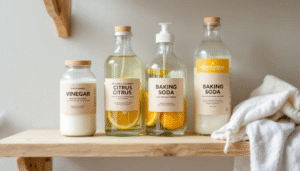Beyond the Basics: 5 Forgotten Cleaning Spots in Your Home You’re Probably Missing

You’ve done it. You’ve spent the afternoon cleaning—the countertops are shining, the floors are vacuumed, the pillows are fluffed. You stand back, admire your work, and enjoy that brief, satisfying moment of a job well done. But is your home truly clean? Or have you, like most of us, fallen prey to “cleaning blindness”?
Cleaning blindness is what happens when we become so accustomed to our own surroundings that we stop seeing the gradual accumulation of dust and grime in the places we don’t look at every day. These overlooked areas are the final frontier between a home that looks tidy and one that feels deeply, hygienically clean.
These forgotten spots are more than just an aesthetic issue; they are reservoirs for dust, allergens, bacteria, and grime that directly impact your home’s air quality and overall health. At Magnolia Cleaning SWFL, our professional training is focused on seeing what others miss. This guide will shine a bright light on five of the most commonly forgotten cleaning spots in any home. We’ll explain why they matter and give you the step-by-step professional techniques to tackle them, elevating your home to a new standard of clean.
Before you begin, make sure to gather the right cleaning supplies—having the appropriate tools and products on hand is essential for effectively tackling these forgotten spots.
The Psychology of Forgetting: Why We Miss These Spots
It’s not that we’re lazy; our brains are simply wired to focus on the obvious. We miss these areas for a few key reasons:
Out of Sight, Out of Mind: Most of these spots are either above our normal line of sight (like the tops of cabinets) or below it (like baseboards). We don’t see them, so we don’t think to clean them.
The “It’s Too Hard” Factor: Tasks like cleaning behind the refrigerator seem difficult and time-consuming, so we procrastinate on them indefinitely.
Focus on High-Touch Surfaces: We are diligent about cleaning the things we touch frequently, like kitchen counters and doorknobs, but we forget the surfaces that just passively collect dust day after day.
By consciously deciding to tackle these areas, you are making the shift from a reactive tidier to a proactive, deep cleaner.
The 5 Forgotten Zones & Your Pro Cleaning Guide
Forgotten Zone #1: The High Ground (Tops of Cabinets, Door Frames, and Light Fixtures)
Why It Matters: Think of these high, flat surfaces as a “dust canopy” over your entire living space. This is especially true in the kitchen, where airborne grease particles mix with dust to create a sticky, grimy film on top of your cabinets. If not cleaned regularly, dust and grease can build up on these surfaces, making them harder to clean and affecting overall cleanliness. Every time a door closes, the A/C kicks on, or air circulates, these accumulated allergens and dust particles are dislodged and float down into the air you breathe and onto the surfaces you just cleaned.
How to Clean It Properly:
Safety First: Always use a sturdy, reliable step stool or ladder. Ensure it’s on a flat, even surface.
Gather Tools: You’ll need a vacuum with a brush attachment, high-quality microfiber cloths, a dry microfiber cloth, a soft brush, and a spray bottle with your chosen cleaner. For greasy kitchen cabinet tops, a solution of warm water and a degreasing dish soap is perfect.
Technique for Dust: For tops of bookcases or door frames, start with a dry microfiber cloth to remove loose dust. Microfiber cloths are excellent because they trap dust instead of just moving it around. You can also use the vacuum’s brush attachment for larger areas, then follow with a damp microfiber cloth to catch any remaining particles.
Technique for Grease: First, use a dry cloth to wipe away loose dust. For delicate light fixtures or intricate cabinet details, use a soft brush to gently remove grime without scratching. Then, lightly spray your degreasing solution onto a microfiber cloth (not directly onto the surface) and wipe down the cabinet tops. Rinse your cloth frequently in clean water to avoid smearing grease. Finish with a wipe from a clean, damp cloth.
Forgotten Zone #2: The Low Ground (Baseboards and Vents)
Why It Matters: We look right past them, but baseboards are magnets for dust, scuffs, pet hair, and pet dander, which can affect indoor air quality. Clean baseboards create a crisp, finished line that makes a whole room look polished. Air vents are the lungs of your HVAC system; if they’re caked in dust, you’re just recirculating allergens.
How to Clean It Properly:
Baseboards: This is a two-step process. First, use your vacuum’s brush attachment to remove dust along the entire length of the baseboards. Second, in a bucket of warm water, add a few drops of a gentle cleaner. Dip a microfiber cloth in, wring it out well, and wipe down the baseboards to remove grime and scuffs. For stubborn grime or marks, apply a baking soda paste and gently scrub. A magic eraser can work wonders on stubborn marks, but test it in a hidden spot first.
Air Vents: Turn off your HVAC system. Use a vacuum brush to remove dust from the vent cover. For a deeper clean, unscrew the cover, wash it in warm, soapy water, and let it dry completely. While it’s off, use a crevice tool to vacuum any visible dust inside the duct opening.
Forgotten Zone #3: The Supporting Cast (Light Switches, Doorknobs, Remotes)
Why It Matters: These are the single highest-touch points in your home, making them hotspots for germ transfer.
How to Clean It Properly:
Safety First: Never spray liquid directly onto a light switch or outlet.
Disinfect Correctly: Lightly spray a quality disinfectant onto a clean microfiber cloth (not the surface itself). Thoroughly wipe down each light switch plate, the entire doorknob (not just the part you grab), and all of your remote controls. Use a cotton swab to clean the grime that builds up around the edges of buttons. After disinfecting, remotes and similar items should be left to air dry to ensure they are thoroughly dried without damage.
Routine cleaning experts suggests wiping high-touch surfaces like doorknobs, handles, and light switches regularly to prevent germ buildup and maintain a hygienic environment.
Forgotten Zone #4: The Inner Workings (Dishwasher Filter, Washing Machine Gasket, etc.)
Why It Matters: True cleanliness includes the parts of your home that work for you. A clogged dishwasher filter means dirtier dishes. A grimy washing machine gasket leads to musty-smelling laundry.
How to Clean It Properly:
Dishwasher Filter: Most modern dishwashers have a filter at the bottom that twists out. Rinse it under hot water monthly to remove trapped food and improve performance.
Washing Machine Gasket: On a front-load washer, gently pull back the rubber seal around the door and wipe inside the fold with a cloth dampened with a 50/50 white vinegar and water solution to kill mildew. Gently scrub the gasket to remove any grime or buildup. Leave the door ajar between washes to let it dry.
Silverware Drawer: Once a season, empty it completely. Vacuum out the crumbs and wipe down the drawer and the organizer tray before putting the silverware back.
Tip: Don’t forget your kitchen drawers—empty them, wipe them down, and replace liners to prevent buildup of crumbs and dust. While cleaning under the sink or in kitchen drawers, check for old sponges and discard them to avoid mold and odors.
Forgotten Zone #5: The Hidden Depths (Underneath and Behind Furniture & Appliances)
Why It Matters: This is the ultimate deep cleaning frontier. The spaces behind and under heavy items are massive reservoirs of dust, pet hair, and lost items. Cleaning them drastically improves air quality. Specifically, cleaning the refrigerator coils can improve its energy efficiency. Areas with high foot traffic, such as under area rugs, tend to accumulate more dirt and grime, making more frequent cleaning necessary to maintain appearance and prevent damage.
How to Clean It Properly:
Under Furniture: Use furniture sliders to easily and safely move heavy items like sofas, beds, and dressers. Vacuum the floor space thoroughly before moving the item back.
Behind the Refrigerator: This requires care. First, unplug the fridge. If it’s on wheels, you should be able to gently roll it forward. Use your vacuum’s long brush attachment to gently clean all the dust from the condenser coils on the back or bottom. Clean the floor, then carefully roll the fridge back and plug it in. If you are not comfortable doing this, or if deep cleaning hard-to-reach areas is needed, it’s a perfect job to leave to professional help.
The Overlooked Impact: How Forgotten Cleaning Affects Your Home’s Air Quality
When it comes to your home’s air quality, what you can’t see can absolutely hurt you. Dust, dirt, and allergens love to hide in overlooked areas like ceiling fans, air vents, and baseboards. Every time you turn on a fan or your HVAC system kicks in, these particles become airborne, circulating throughout your home and potentially triggering allergies or respiratory issues. This is especially important during cold and flu season, when maintaining a healthy environment is crucial.
Regular deep cleaning of these forgotten spots makes a big difference. Start by using a vacuum cleaner with a brush attachment to remove loose dust from vents, fan blades, and baseboards. Follow up with a damp microfiber cloth to trap any remaining particles—microfiber is especially effective at grabbing dust without just pushing it around. For stubborn dirt, a mild cleaning solution works wonders and helps avoid the unpleasant odors that harsh chemicals can leave behind.
Don’t forget to sprinkle baking soda on carpets and upholstery before vacuuming to neutralize odors and freshen the air. You can also use a dryer sheet to gently wipe surfaces like baseboards or fan blades to help repel dust between cleanings. By prioritizing thorough cleaning in these often-missed areas, you’ll notice a fresher, healthier home—and your lungs will thank you.
Waste Not: The Forgotten Art of Smart Waste Management
Trash cans and recycling bins are some of the most overlooked areas when it comes to cleaning, but neglecting them can lead to unpleasant odors, mold growth, and even pest problems. To keep your home truly clean, make it a habit to empty trash cans regularly and give them a deep clean at least once a month.
Start by washing trash cans and recycling bins with hot water and a mild cleaning solution. Scrub the inside and outside thoroughly, paying special attention to any sticky residue or lingering smells. Rinse with warm soapy water and allow them to dry completely before putting in a new liner—this helps prevent moisture buildup and mold growth. For extra freshness, sprinkle a little baking soda in the bottom of your trash can to neutralize odors between cleanings.
Don’t forget to clean behind and underneath your bins, as dust and dirt can accumulate in these hidden spots. If you have a lint trap in your laundry area, check the care label for proper cleaning instructions and make sure it’s cleared regularly to prevent fire hazards and keep your appliances running efficiently. By staying on top of these often-forgotten tasks, you’ll reduce waste, keep pests at bay, and maintain a cleaner, healthier home.
The Magnolia Standard: Where “Forgotten” is on the Checklist
Reading this list might feel overwhelming, but for a professional service like Magnolia Cleaning SWFL, these aren’t “forgotten” spots. They are integral parts of our signature deep cleaning service. Our teams are trained to see a home with an expert eye, and our comprehensive checklists ensure that no detail, high or low, is ever overlooked.
Hiring a professional service means you are investing in thoroughness. It saves you the time and physical strain of these difficult tasks and guarantees they are done safely and correctly. This commitment to a truly whole-house clean is how we deliver a healthier, more beautiful home to our Naples clients.
Ready to experience a level of clean that leaves no corner untouched? Contact us today to learn about our comprehensive deep cleaning service.
Avoiding the Pitfalls: Common Cleaning Mistakes (and How to Fix Them)
Even the most diligent cleaners can fall into common traps that make cleaning less effective—or even risky. One of the biggest mistakes is forgetting to clean high-touch surfaces like door knobs, light switches, and remote controls. These areas can harbor germs and bacteria, especially during flu season. To gently clean them, use a disinfectant wipe or a solution of equal parts vinegar and water on a microfiber cloth, making sure to get into crevices and around buttons.
Another frequent error is reaching for harsh chemicals, which can damage surfaces and leave behind strong odors. Instead, opt for mild cleaning solutions or natural alternatives like baking soda and lemon oil. Baking soda is great for scrubbing away sticky residue or neutralizing odors, while lemon oil can help polish and protect surfaces.
Always read the care label before cleaning items like area rugs or slipcovers, and test any new cleaner on a small, hidden spot first. Avoid using too much water, especially on wood or electronics, to prevent mold growth and damage. And don’t forget to clean those truly forgotten spots—like the top of the refrigerator, range hood, and picture frames—where dust and dirt love to settle. By being mindful of these pitfalls, you’ll ensure a safer, more thorough cleaning routine.
Frequently Asked Questions (Q&A)
Q1: How often do I really need to clean these forgotten spots? We recommend a rotating schedule. High-touch spots like light switches and remotes should be wiped weekly. Baseboards and vents benefit from a monthly cleaning. The most intensive tasks, like cleaning behind appliances, are perfect for a semi-annual or annual deep clean.
Q2: Cleaning behind my refrigerator seems risky. Is it worth it? It is absolutely worth it for improving your home’s air quality and your appliance’s energy efficiency. However, you are right to be cautious. If you are at all uncomfortable moving the appliance, this is one of the best tasks to leave to a professional team that is trained and insured to perform the job safely.
Q3: What is the best tool for dusting high places without making a bigger mess? An extendable microfiber duster is the ideal tool. Unlike old feather dusters that push dust into the air, the electrostatic charge of microfiber traps and holds onto dust particles. When you’re done, you can wash the duster head and reuse it.
Q4: My baseboards have scuff marks that won’t come off with a wet cloth. What should I do? For stubborn scuff marks from shoes, a melamine foam sponge (like a Mr. Clean Magic Eraser) is very effective. Wet the sponge slightly, wring it out, and gently rub the mark. Because it is a mild abrasive, it’s always wise to test it on a small, inconspicuous area first to ensure it doesn’t affect the paint’s finish.
Q5: Are these deep cleaning tasks included in a regular, recurring service from Magnolia? Our recurring maintenance cleans are designed to keep your home at a high standard of cleanliness by focusing on the primary, most-used surfaces. Our Deep Cleaning Service is the comprehensive package where we specifically dedicate time to tackle all of these “forgotten” zones. Many clients book a Deep Clean once or twice a year to supplement their regular maintenance service.
Conclusion: The Power of Remembering the Forgotten
The secret to a truly clean home lies in the details—those overlooked areas that are easy to forget but make a world of difference when cleaned regularly. By embracing deep cleaning, smart waste management, and avoiding common cleaning mistakes, you’ll improve your home’s air quality, reduce the risk of mold growth, and make your life easier in the long run.
Don’t forget to tackle those forgotten spots like ceiling fans, air vents, and baseboards, and use natural helpers like baking soda and lemon oil to neutralize odors and keep your home smelling fresh. Whether you’re gearing up for spring cleaning or just want to maintain a healthier space year-round, remembering the forgotten is the key to a happier, healthier home. So grab your microfiber cloth, make a checklist, and enjoy the peace of mind that comes from knowing every corner of your home is truly clean.




